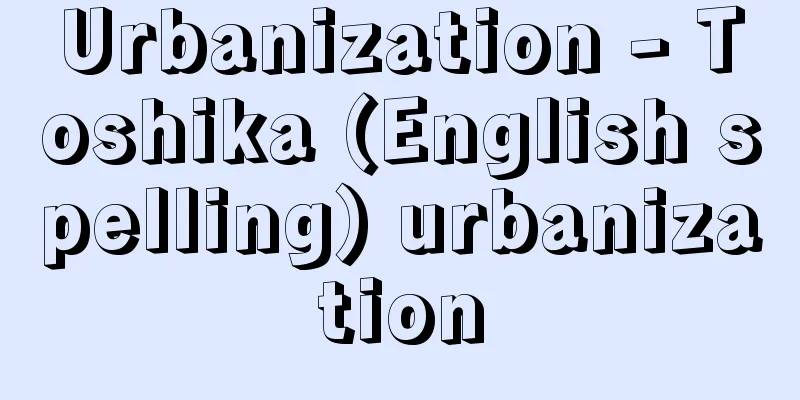Urbanization - Toshika (English spelling) urbanization

|
This refers to the process in which the population concentrates in cities, and the lifestyles unique to cities accumulate and strengthen, penetrating and spreading to the outskirts of cities and rural areas. Urbanization trendsThe lifestyle peculiar to a city can be understood from three aspects: social structure, life structure, and consciousness structure. Therefore, urbanization is nothing but a change in these three structures, and is one of the social changes. First, changes in social structure refer to the concentration and dispersion of population, changes in population composition (sex ratio, etc.), increased population movement and mobility, changes in land use (concentric expansion), suburbanization (urbanization), fluidization and homogenization of class and hierarchical structures, concentration and dispersion of institutions and facilities, the succession of independent groups, and changes in family form (nuclearization). Of these, population concentration and suburbanization (urbanization) are generally understood as synonymous with urbanization. Changes in life structure refer to the diversification of group participation, the weakening and one-sidedness of neighborhood relationships, the simplification and individualization of family relationships, and the transition to specialized systems for life functions (for example, childcare functions). Of these, the weakening of neighborhood relationships is often cited as an example of urbanization, along with the poem "What is the neighbor doing in the deep autumn?" Furthermore, the change in the consciousness structure means the formation of urban personality (stereotypes, individualism, cosmopolitanism, standardism, etc.), the formation of civic consciousness, and the increase in individual disintegration, mental disorders, suicide, delinquency, and crime. Of these, urban personality is likely to be familiar to a relatively large number of people. These structural changes are not the whole of urbanization, but merely a partial example, and some of them remain in the realm of hypothesis, but these structural changes are understood as a process of accumulation and penetration of urban lifestyles. However, there are several conditions attached to this understanding of urbanization. First, this urbanization must be limited to that which has occurred in conjunction with industrialization since the modern era. This is because pre-modern urbanization is thought to have occurred against a background of industrialization different from that of the modern era. Second, this urbanization should be understood only in the context of the same society and culture, i.e., Japan, and simple comparisons with other countries are not permitted. Even urbanization phenomena that appear to be the same must occur in different contexts. Third, a distinction must be made between the levels of urbanization, such as society as a whole, local communities, and individuals. The urbanization of society as a whole (urbanized society, that is, a society in which the entire society has been urbanized and transformed into a single urban society), the urbanization of local communities (urbanization of cities and rural areas as seen in urban redevelopment, hollowing out of city centers, and the advancement of urban functions), and the urbanization of individuals cannot necessarily be perceived on the same level. [Yuetsu Takahashi] Research ProcessResearch into urbanization began with L. Worth's theory of urban sociology, which has influenced adjacent sciences as well. Worth defined a city by the amount, density, and heterogeneity of its population, regarding these as independent variables, and believed that each city creates a world of its own urban lifestyle (urbanism), in other words, urban society, which is the dependent variable. He considered urbanization to be the process by which this urban lifestyle accumulates and permeates to create urban society. Since then, this theory of urbanization has undergone various criticisms and modifications and has continued to the present day. In the 1970s, large European cities such as London and New York faced an "urban crisis" characterized by problems in the inner cities (the periphery of the center of a large city), and subsequently underwent "urban regeneration" through redevelopment projects and other means. Regarding the process of urban decline and regeneration, L. van den Berg (1948-) and LH Klaassen (1920-1992) presented a four-stage development model of urbanization, suburbanization, deurbanization, and reurbanization through the analysis of European cities. In this model, urban areas are divided into a core and a ring, and the population of urban areas increases in the urbanization and suburbanization stages and decreases in the deurbanization and reurbanization stages. Since the 1980s, attention has been paid to the problem of deindustrialization in Japan, where the economic base of the region has declined due to the outflow of factories, and the problem of inner cities where foreigners, mainly Asians, have invaded. Since the late 1990s, Tokyo has seen a trend toward re-urbanization, or a return to the city center. As part of urban redevelopment, low-income residential areas are restored and residents are replaced by the middle class, a phenomenon known as gentrification. Research on urban regeneration has been conducted around this phenomenon. [Yuetsu Takahashi and Ken Harada] Urbanization in JapanJapan's modern urbanization began in the Meiji era, when the capitalist system was introduced and new industrialization began. There were remarkable developments in industrialization, such as the Industrial Revolution in the mid-Meiji era, the shift to heavy industry from the Meiji era through to the Taisho era, and the growth of industrial production in the mid-Taisho era, which promoted urbanization considerably. In Tokyo, suburbanization progressed rapidly after the Great Kanto Earthquake in 1923 (Taisho 12). In the Showa era, and from the late 1950s after World War II, urbanization progressed rapidly along with high economic growth, and the three regions of Tokyo, Osaka, and Nagoya in particular formed large metropolitan areas. The regional units that indicate the degree of urbanization are the city area as an administrative division and the densely inhabited district (DID) which is based on the census block. The ratio of the urban population to the total population was 18.0% in 1920, but rose rapidly during the postwar period of high economic growth, exceeding 70% in 1970 (Showa 45). The rate of increase slowed down after the late 1970s, but due to the effects of the Heisei Great Mergers, it reached 90.7% in 2010 (Heisei 22). The city area as an administrative division created by these mergers includes areas that are not necessarily appropriate to be considered as cities. If the population of the densely inhabited districts instead of the city population is used, the problems associated with the reorganization of administrative divisions like this can be avoided. In fact, the population of the densely inhabited districts to the total population was 67.3% in 2010. [Yuetsu Takahashi and Ken Harada] "Restructuring Metropolitan Society: Tokyo's Inner City Problems" edited by Takahashi Yuetsu (1992, Nippon Hyoronsha) " "Urban Sociology in the 21st Century" edited by Kikuchi Miyoshi and Egami Wataru (2002, Gakubunsha)" " Urban Sociology Selection I: Modern Urbanism" edited by Matsumoto Yasushi (2011, Nippon Hyoronsha) [References] | | | | | | | |Source: Shogakukan Encyclopedia Nipponica About Encyclopedia Nipponica Information | Legend |
|
都市への人口集中、および都市に特有な生活様式が累積・強化され、都市周辺や農村に浸透・拡大していく過程をいう。 都市化の動向その都市に特有な生活様式は、社会構造、生活構造、意識構造の三つの側面から把握され、したがって、都市化は三つの構造の変化にほかならず、社会変動の一つをなすものである。まず、社会構造の変化は、人口の集中と分散、人口構成(性比など)の変化、人口移動・流動の増大、土地利用の変化(同心円的拡大)、郊外化(市街化)、階層・階級構造の流動化・均質化、機関・施設の集中と分散、自主的な集団の続発、家族の形態の変化(核家族化)などを意味している。このうち、人口集中や郊外化(市街化)は、一般に都市化の代名詞のように理解されているものである。生活構造の変化は、集団参加の多様化、近隣関係の希薄化・一面化、家族関係の単純化・個人化、生活機能(たとえば保育機能)の専門的制度への移行などを意味している。このうち、近隣関係の希薄化は、「秋深き隣は何をする人ぞ」の句とともに、しばしば都市化の例証として引き合いに出されているものである。さらに、意識構造の変化は、都市的パーソナリティー(ステレオタイプ、個人主義、コスモポリタニズム、標準主義など)の形成、市民意識の形成、個人解体・精神障害・自殺・非行・犯罪の多発などを意味している。このうち、都市的パーソナリティーは比較的多くの人々になじみ深いものになっているであろう。 これらの構造変化は都市化のすべてではなく、その一部の例示にすぎず、また仮説の域を出ていないものもあるが、これらの構造変化が都市的生活様式の累積・浸透の過程として把握されるわけである。ただし、この都市化の把握には、いくつかの条件がついている。第一に、この都市化は、近代以降の産業化(工業化)に伴っておこるそれに限定されなければならない。近代以前の都市化は近代以降とは異なる産業化を背景におこったと考えられるからである。第二に、この都市化は、日本なら日本という同一の社会・文化の文脈でのみ理解されるべきであって、外国との単純な比較は許されない。同じようにみえる都市化の現象でも異なる文脈でおこっているはずである。さらに第三に、この都市化には、全体社会、地域社会、個人などのレベルを区別しなければならない。全体社会の都市化(都市化社会、つまり、社会全体が都市化され、一つの都市社会のように変容した社会)、地域社会の都市化(都市再開発、都心の空洞化、都市機能の高度化などにみられる都市の都市化、農村の都市化)、および個人の都市化は、かならずしも同一のレベルでとらえることはできない。 [高橋勇悦] 研究過程都市化の研究は、L・ワースの都市社会学の理論に始まり、隣接科学にも影響を及ぼしたといってよい。ワースは、都市を人口の量、密度、異質性で定義して、これを独立変数とみなし、その都市が独自の都市的生活様式(アーバニズムurbanism)の世界、つまり従属変数としての都市社会をつくると考えた。この都市的生活様式が累積、浸透して都市社会をつくっていく過程を都市化とみなしたのである。それ以後、この都市化の理論はさまざまの批判と修正を経て今日に至っている。 ロンドン、ニューヨークなどの欧米における大都市は、1970年代に入ってインナーシティ(大都市中心周辺部)問題に特徴づけられる「都市の危機」(urban crisis)に直面し、その後、再開発事業などを通じて「都市の再生」を経験した。都市の衰退と再生のプロセスに関して、ファン・デン・ベルクL. van den Berg(1948― )、クラッセンL. H. Klaassen(1920―1992)らは、ヨーロッパの都市の分析を通じて、都市化、郊外化、反都市化、再都市化という4段階の発展段階モデルを提示した。このモデルでは、都市圏は中心部coreと周辺部ringに区分されており、都市圏人口は都市化と郊外化の段階で増加し、反都市化と再都市化の段階で減少している。1980年代以降、日本においても工場の流出に伴い地域の経済基盤が低下した産業空洞型や、アジア系外国人を中心とする外国人流入型のインナーシティ問題が注目された。東京では、1990年代後半以降、再都市化とよぶべき「都心回帰」の傾向が現れた。都市再開発に伴い、低所得層の居住区が修復され、居住者が中間層に入れかわっていくジェントリフィケーションgentrificationをめぐり、都市の再生に関する研究が展開されている。 [高橋勇悦・原田 謙] 日本の都市化近代以降の日本の都市化は、明治に入り、資本主義体制が導入され、新しい産業化が展開するとともに始まった。明治中期の産業革命、明治から大正にかけておこった重工業化、大正中期の工業生産の成長など、産業化の展開は著しいものがあり、それによって都市化もかなり促進された。東京では、1923年(大正12)の関東大震災以降、急速に郊外化が進んだ。昭和に入り、第二次世界大戦後の1950年代後半以降、経済の高度成長とともに都市化は急速に進展し、とくに東京・大阪・名古屋の3地域は大都市圏を形成した。 都市化の程度を示す地域単位として、行政区画としての市部と国勢調査区を基礎単位とする人口集中地区(DID=Densely Inhabited District)があげられる。総人口に占める市部人口の割合をみると、1920年は18.0%であったが、戦後、高度経済成長期に急速に上昇し、1970年(昭和45)には70%を超えた。1970年代後半以降、上昇率は鈍化したが、平成の大合併の影響により、2010年(平成22)は90.7%に達している。この合併によって創設された行政区画としての市部には、都市とみなすにはかならずしも適切でない地域が含まれてしまう。市部人口ではなく人口集中地区の人口を用いれば、こうした行政区画の再編に伴う問題は避けられる。実際、総人口に占める人口集中地区の人口は、2010年は67.3%になっている。 [高橋勇悦・原田 謙] 『高橋勇悦編『大都市社会のリストラクチャリング――東京のインナーシティ問題』(1992・日本評論社)』▽『高橋勇悦監修、菊池美代志・江上渉編『21世紀の都市社会学』(2002・学文社)』▽『松本康編『都市社会学セレクションⅠ 近代アーバニズム』(2011・日本評論社)』 [参照項目] | | | | | | | |出典 小学館 日本大百科全書(ニッポニカ)日本大百科全書(ニッポニカ)について 情報 | 凡例 |
<<: Town gas - Toshigasu (English spelling) town gas
Recommend
Cementite - Cementite
The compound of iron and carbon (Fe 3 C) is calle...
Europhielia
…(3) South Africa and Madagascar There are few ge...
Shimokawabe Yukihira
Years of birth: Years of birth and death unknown. ...
Inazo Nitobe - Nitobe Inazo
Educator and agricultural policy scholar. Born in...
scolex
…Adult worms that parasitize the human body usual...
Electron spectroscopy
A general term for methods of irradiating a materi...
Borgholm
...The population is about 20,000, and they are m...
Shu - Food
A dynasty during the Three Kingdoms period in Chi...
Layers - Kasane
[given name] 1. To stack something. Also, somethin...
electrification
…An object originally carries equal amounts of po...
Cooper, KH
...Both are technical terms in exercise physiolog...
Ernest Maltravers
… [Relationship with Japanese literature] The Jap...
Shy Lover - Uchikinakoibito
Lyric poetry, which contains infinite shades of m...
Mississippi [State] - Mississippi
A state in the southern United States. Abbreviated...
Orbital index - orbital index
… N is called the normalization constant because ...









